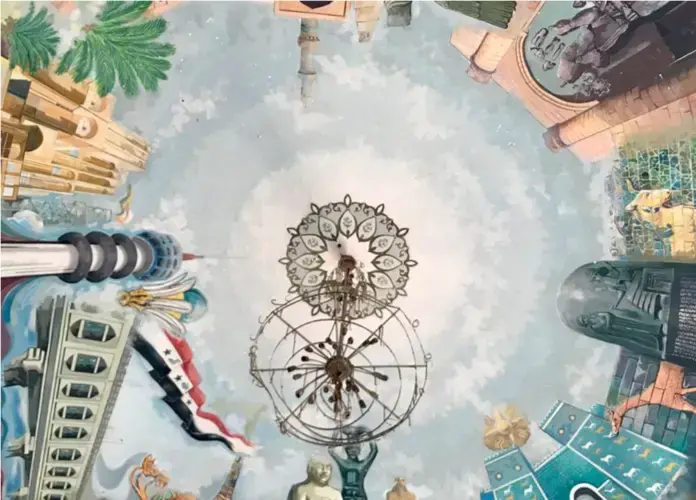
There weren't many signs guiding Samira, Rasul and I to Babylon.
Learning that Mesopotamia -- the cradle of civilization – stretched through Iraq was monumental for me as a kid. It was the first time I'd felt true pride being Iraqi.
Babylon is best known in Western culture as the fallen, disreputable city featured in the Bible. But before that, it was a key city in Mesopotamia. It's just an hour away from Rebab's house, so we decided to visit on our way to the city of Najaf.
"I told them to take you because I know you like that stuff," Baba said over the phone.
My first days in Iraq were spent at parks and malls. I had to walk through security checkpoints to get into public areas. There were two lines, one for men and the other for women, which led into a room where I was patted down for weapons.
There were posters of men plastered on poles and buildings all over Baghdad. They faded away the farther you were from the city.
"They were killed fighting for Iraq," Samira said.
Iraq's borders were unsecured after the 2003 U.S. invasion. Since then, radical and extremist groups and handfuls of political parties have tried to rule. Armed soldiers guard checkpoints between each city and ask where you're going before letting you pass.
The highway is powdered with sand.
When we got stuck in traffic, handfuls of men, women and children roamed the streets selling snacks and bubble-blowing toy guns.
"There's no work in Iraq," Rasul said sipping from the tea he'd just bought. "You could have a master's degree and still be working in the streets. Here it's not about what you know, it's about who you know."
People in Iraq are frustrated with poor wages, but still work hard every day to earn them.
"During the days of Saddam, I would work a week and make enough for a few bananas," Samira said.
Along the way, Rasul stopped at small wagons selling heads of lettuce, gum and tea. Iraqis are prideful of their country, despite its struggles.
"Don't be silent, speak," Rasul said. "I've always been silent. I never wrote or spoke about what I saw. That was a mistake. Our most powerful tool is the spoken word."
Rasul told me this parable in reference to my work as a reporter.
"A fish will swim in between rocks in the river and lay hundreds of eggs, but no one will know about it. A chicken will lay a single egg and the whole village knows it laid an egg. Because the chicken used its voice and it carried. Be the chicken, use your voice as a journalist, even if it's just one egg you've laid. Let the world know our story."
Looted Treasures
We made it to the ancient city of Babylon with the direction of some armed soldiers.
The parking lot outside of the once-booming ancient city was nearly empty.
Babylon was built on the Euphrates River, which runs directly through the ancient city, splitting it in half. The city's deep embankments help contain the river's seasonal floods.
Tall blue walls painted with horses led to a metal archway decorated with floral patterns. It was Rasul's and Samira's first time visiting.
Before walking its ruins, we toured a small museum about Babylon. There were intriguing artifacts, like a small stone tablet with mathematical text enshrined onto it. But some items were missing.
"Everything was looted," Rasul said. "Things that belong here aren't here anymore."
The Ghost of Saddam
The ruins of Babylon are essentially a stone maze in the desert. Each narrow hallway led to a room which opened into another hallway. Within the wall's bricks are inscriptions reminding visitors of Saddam's reign.
Babylon's grounds are littered with plastic bottles and bags, a heap often accumulated in a single room. Once out of the maze, a path led us up a hill where we could oversee the entirety of the city. Gazing across the land, I couldn't help but notice a large castle sitting on top of the hill overlooking Babylon.
"Whose castle is that?" I asked Rasul.
"Saddam's," Rasul replied.
We walked through shrubs and over fallen trees to get to Saddam's castle. The uphill walk showed us Babylon's twists and turns.
At the top, a mural decorating the castle's doorway welcomed us. The mural depicts men building, harvesting land and carrying the Iraq flag into battle. It is dedicated to Saddam.
His enormous castle was empty inside.
Its marble walls were covered in graffiti condemning Saddam's regime. Aside from the wooden moldings carved with date trees, the rooms were bare, stripped down to their marble floors.
Footsteps and voices of families running, laughing and playing echoed through the castle.
In the largest room a group of boys played soccer. The soccer ball smacked hard against the castle walls as a boy prepared to kick it back.
In another large room, a mural featuring Saddam's marker beside every great Iraqi monument was painted on the ceiling. A woman in traditional ancient Mesopotamian clothing, the Lion of Babylon, Ctesiphon and other ancient Iraqi cities circled around to the Baghdad Tower, formally known as the Saddam International Tower.
"Look at how much he loved himself," Rasul said, pointing up at the mural.
The mural is to remind every visitor who walks through Saddam's castle of his mark on Iraqi history.


Education Resource
Meet the Journalist: Zahra Ahmad
In February 2019, Zahra Ahmad traveled back to her homeland, Iraq, to reunite with her father's...







